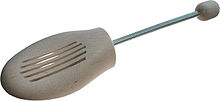Shoe trees
Shoe trees (also called shoe stretchers or clamping bars ) are shaped pieces that fill the front part of the shoe and that are inserted into the shoes after they have been worn . They are used for shoe care.
function
Shoe trees ensure an optical shape retention and the fit of low shoes and boots, especially for shoe uppers made of leather. Gusseted creases (creases in the shaft above the metatarsophalangeal joints caused by the compression of the material when walking) are compensated for by shoe stretchers. With sewn shoes , they relieve the floor seams . Due to the drying of the leather, which is always somewhat damp due to foot exhalations, after the shoes have been worn, there is a risk that the shoe bottom will curve upwards over time from the upper that contracts during drying. This leads to a shortening of the shoes, so that at some point they no longer fit. Shoe stretcher with screw thread and folding handle prevent this effect. If the clamping strips are made of untreated wood, they allow the shoe that has become damp due to foot exhalation to dry more quickly.
materials
The traditional material for shoe trees is wood. Usually beech wood is used. The wood of the giant North American tree of life , better known under the trade name "cedar wood", is used for higher quality shoe trees . Shoe trees made of poplar wood (particularly light and suitable for travel shoe trees ) or made of tropical types of wood are less common .
Low-priced shoe trees are made of hard plastic (polypropylene, PP). The viscose-coated hard foam, so-called half-tensioner (see below), consists of polyurethane (PU).
Sizes, shapes, types
Shoe trees are offered to match the shoe size . Shoe trees usually consist of three parts: at the front the front sheet, which fills the front part of the shoe, at the back the heel piece, which fills the rear flap, and in between a third part that ensures the length of the tensioner to match the shoe, so that the shoe stretcher is slightly tensioned in the shoe lies. Either one or two telescopic springs between the front leaf and heel piece or a length-adjustable screw connection or a coil spring ensure this. More rarely, wooden shoe stretchers are offered, which have a wedge-shaped wooden middle part similar to a last , which creates the desired tension when pushed between the front part and heel part.
Some manufacturers offer the front blades in different widths and shapes. For very wide shoes there are shoe trees with two-part front leaves that are pressed apart by means of spring tension.
For ankle boots there are shoe stretchers with a longer and raised front blade. Shoe stretchers for shaft boots consist of a foot and a leg part. The foot part largely corresponds to a normal shoe stretcher. The leg section is adjustable in the calf width.
In order to ensure good ventilation of the shoe, most shoe stretchers only rest on the edge of the insole and their front blades have slit-shaped or round recesses.
Mainly for light women's shoes, half-tensioners are also offered, which consist of only one front sheet and are loosely inserted into the front part of the shoe.
Boot stretcher and shaft former
There are also boot trees for boots. They ensure that the shaft tube and foot part of the boot retain their shape while minimizing creases, as well as ensuring air circulation inside the shoe because the shaft tube can then no longer fold over to the side.
Boot trees consist of a foot and leg piece made of plastic or wood. These are either connected or, in the case of inexpensive versions, two separate pieces. The leg piece consists of two main parts that fill the shaft tube with an elongated wedge that can be manually moved in between and bring it to light tension.
Instead of special boot trees, normal shoe trees in the foot part of the boot in connection with shaft formers in the shaft tube also serve the same purpose and also enable better air access to the inside of the boot. Stock formers (short for boot stock formers) consist of two light, elongated shells made of plastic or wood that are connected to one another under elastic tension. Inserted into the boot tube, they hold it open and upright under slight tension. A hanging device at the upper end of the shaft former also enables the hanging storage of boots.
Boot trees and shaft formers are available in different sizes that fit different calf widths and boot tube lengths.
Useful information for selection and use
The most important criterion of a shoe tree is its fit. An optimal fit is given when the shape of the front sheet corresponds to the front part of the shoe and fills it as well as possible in terms of volume. So that the shoe is not excessively tensioned, it is important that the length of the shoe stretcher matches the shoe size. If the heel piece is too small, too angular or too narrow, the heel of the shoe will be deformed and unnecessarily stressed. Wide, softly rounded heel pieces protect the shoes.
In order to avoid wearing out soft, thin shafts and light shoes (e.g. moccasins ), half-tensioners (shoe stretcher without heel piece) are inserted into these.
Coil spring tensioners can put unnecessary strain on shoes if they exert too much tension or pressure in addition to the small heel piece.
Shoe trees are inserted into the still warm shoes immediately after wearing, so that the leather, which has expanded during wearing, retracts into its original shaft shape when it dries. To do this, the shoe stretchers have to stay in the shoes for at least a full day.
literature
- Helge Sternke: Everything about men's shoes . Nicolai, Berlin 2006, ISBN 978-3-89479-252-7 .




